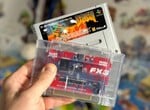
I was recently fortunate enough to go hands-on with the 2025 update of DOOM on the SNES, developed by Randal Linden and due to be published by Limited Run Games.
When the project was first announced, Linden – who also worked on the original 1995 port of the game for Nintendo's 16-bit console – hinted that he was developing what would unofficially be known as the "Super FX 3", a more powerful take on the graphics chip originally produced by Argonaut for 1993's groundbreaking Star Fox.
However, it has since been revealed that this chip is, in reality, a Raspberry Pi RP2350B. This has predictably led to a handful of people grumbling online, with some even going as far as to claim that it's this chip that is doing all of the heavy lifting, and not the SNES itself.
Linden has responded to these comments and clearly feels they show a lack of understanding about how this chip functions – and how past add-on chips worked back in the 1990s:
The new DOOM SNES 2025 is the culmination of almost three years of work across software, firmware and hardware by many individuals across the globe.
The hardware was designed and developed by @BitmapBureau in the UK (hey, Matt, Gavin and Mike!) and uses a state-of-the-art Raspberry Pi RP2350B running at 150Mhz as the graphics co-processor, similar to the SuperFX in the original DOOM SNES.
The RP2350B emulates the SuperFX hardware, registers, memory map and chunky-to-planar graphics logic by running custom firmware that's generated by an ahead-of-time static converter.
This tool takes the SuperFX (GSU) code and data and produces C code which is then compiled by the Raspberry Pi SDK to make an ARM binary.
The Reality Engine 2 combines the 65816 and ARM binary just like the original DOOM SNES did with the SuperFX 2.
The same hardware interface, memory map and protocols are used to communicate between the chips.
Pre-orders for this new version of DOOM go live later this week.


